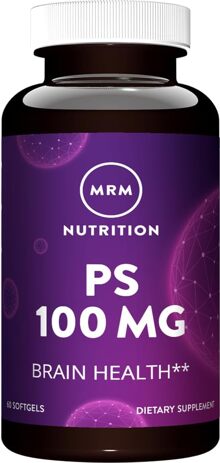
MRM PS (Phosphatidylserine)
Go to Store| Serving Size: 1 Softgel | ||
| Servings Per Container: 60 | ||
| Amount Per Serving | % DV * | |
| Vitamin C (as ascorbic acid) | 10mg | 17% |
| Phospholipid Complex | 480mg | * |
| Phosphatidylserine | 100mg | * |
| Phosphatidylcholine | 50mg | * |
| Phosphatidylethanolamine | 20mg | * |
| Phosphatidylinositol | 10mg | * |
|
* % Daily Value (DV) is based on a 2,000 calorie diet. Your daily values may be higher or lower based on your calorie needs.
† Daily Value (DV) not established. |
||
|
Other Ingredients: Contains Soy. Gelatin, other phospholipids, glycerides and soy oil. |
||
|
Directions: Suggested Usage: Take 1 softgel up to 3 times daily with a meal or as directed by your qualified healthcare provider. |
||

MRM PS (Phosphatidylserine)
Go to StorePhosphatidylserine (PS) is a naturally occurring phospholipid in the brain that exerts a number of metabolic effects.* Numerous studies have suggested the impact of PS on specific neurotransmitters in the brain including acetylcholine, serotonin, norepinephrine and dopamine.* Many researchers also agree that all of these neurochemical systems are involved in cognitive functioning.
Recently, researchers have been conducting human trials directed at supporting healthy memory and brain function. These investigations led to a particular interest in Phosphatidylserine.
PS is a naturally occurring phospholipid in the brain that demonstrates a number of effects on the body (1).* PS in the brain affects a variety of nerve cell functions including the conduction of nerve impulses, the gathering and discharge of neurotransmitters (acetylcholine, serotonin, norepinephrine and dopamine) and the maintenance of cellular function - "homeostasis".
Metabolic Response Modifiers (MRM) provides PS derived from soy. PS is suggested to be highly bioavailable when taken orally and studies suggest no side effects with use up to 800 mg (Fahey and Pearl, 1998).* Based on the research that has been performed on PS, it is suggested that PS may be a promising candidate for increasing exercise performance.*
REFERENCES:
- Reprod Fert Suppl. 46: 155, 1993.






